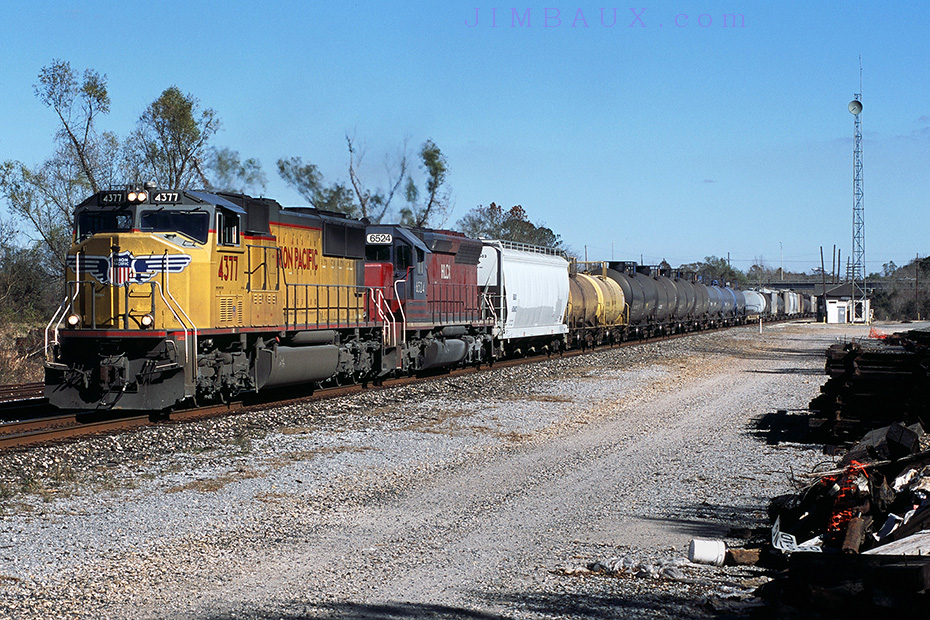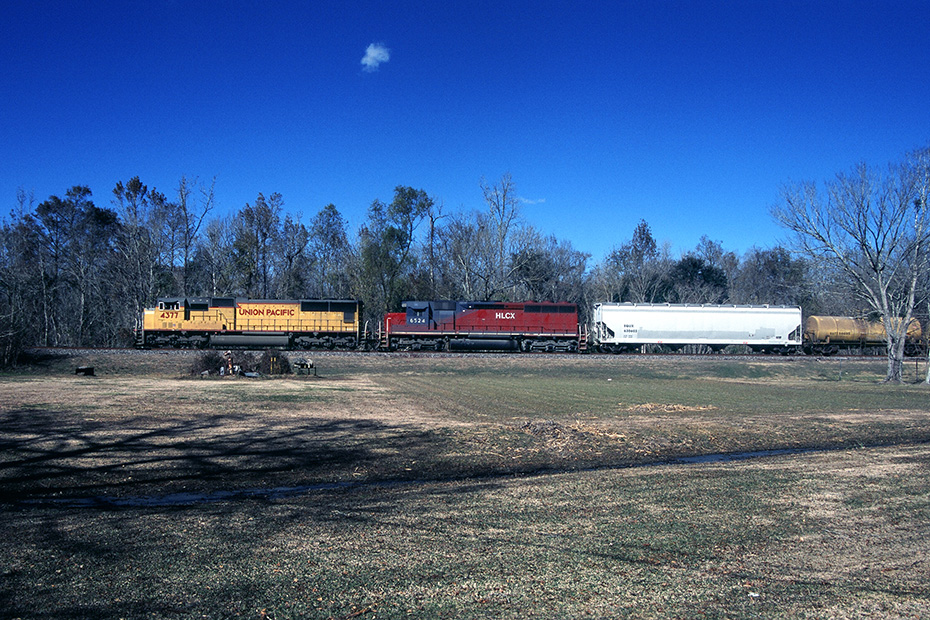These images were made on Sunday 21 December 2003. Remember, as described in the post for the Friday 19 December 2003 picture, this was the beginning of a two-week flurry of railroad photography for the combination of reasons described in that post.
On this day, I did a new shot, at a place called Thoroughbred Park. I would do this shot a few more times over the course of this winter, as best as I can tell, all of eastbound trains, but it seems that I haven’t done it much if at all after the middle of 2005, perhaps because it’s difficult to reach and because tree growth has made it unviable.
The train that I recorded in my first shot at Thoroughbred Park was the P-LACNWO1-17, an intermodal train from Los Angeles to New Orleans (Bridge City, actually) that had made a “CSXT 9000 west” train at Schriever. Because I am weird like that, and because this was my Sunday Sermon, I made a poem of the occasion.
Sunday Services
‘Twas the Sunday before Christmas
And I went look for a trains.
When I missed an eastbound,
It caused me great pains.
I took off at high speed,
And I was really pissed.
I was determined to catch
The train I had missed.
I knew I didn’t have
To do too much riding,
Because he was at Schriever,
And he’d gone into the siding.
So, with the holiday cheer,
And full of pride,
I went to east Thibodaux
To try a new broadside.
It was 08:26,
And BNSF 5341 was in the lead
As I popped some pictures
Standing atop my steed.
What train was it?
I really don’t know,
But it was an eastbound stack train;
So, it must have been the P-LACNWO.
When the detector went off
At milepost 49.6
I knew I had gotten
The last of my pics.
152 axles
Was the count,
And from atop my truck
It was time to dismount.
Why do I do this?
I don’t know the reason.
But I’m surely happy
That it’s train season.
So, will there be
Any more sightings today.
Time will only tell
What the railroads will throw my way.
Trains will be coming
From far and from near.
And, to me, it brings
great holiday cheer.
Yeah, I Know. I’ll Stick To Pictures And Prose.
Anyway, my powers of prediction – of my own actions – were accurate, as I did get back out there and find more trains and photograph them.
I’ll dispense with the foolish poetic garbage and get right to it. While at Schriever around 12:10, I heard the dispatcher talking to a “UP 4377 west” at milepost 43. Ah, finally, it’s a westbound train, just when the light is getting good for westbound trains.
I knew as soon as I made a post about all the foreign power that the next UP train that I would see would have UP power.
And so it was.
As it turned out, this train was the MNOEWB, New Orleans to Englewood Yard (Houston.) It had to stop to align the east siding switch in Schriever.
It had the following power.
UP 4377 – SD70M
HLCX 6524 – SD45 body
(You didn’t think it would be a solid UP consist, did you?)
I photographed it in Schriever at 12:32.
Since it had only two locomotives, I knew that it would struggle to get back to full speed. So, I thought I could repeat my feat of yesterday. I photographed it again in Chacahoula at 12:45.
The detector indicated a train of 460 axles moving at 33mph. Both units were struggling.
Trying to keep the streak of shooting from new photo locations alive, I sped west to Morgan City. At 13:12, out of breath, I photographed it again from atop the Louisiana Highway 182 (former US Highway 90) bridge in Morgan City, apparently the first of many times that I do this shot, a shot that I would do often in 2012 when I worked professionally in the area.
This bridge actually has a shoulder that makes it feel “safe” to shoot from it, but my note about being out of breath suggests that I climbed the bridge, which I know that I did again, along with Shawn Levy, in April 2005 when SP 745 passed through; so, I am not sure when I relented and started parking my automobile on the bridge, but it probably was shortly after that.
Anyway, I gave up chase of this NOEWB and headed home. Around Gibson, I heard the dispatcher talking to another westbound train at Schriever! Hmmmm. What do I do?
Despite the growling stomach, I spun around and headed back west. I thought about going atop the bridge again, but I decided to once again shoot from a new location. I remembered a place on Louisiana Highway 182 (former U.S. Highway 90) that was parallel to a rail bridge over some sort of channel or river which I later learned to be Bayou Ramos. I thought it would make a nice broadside shot.
I pulled alongside the north side of the road facing east, just west of the bridge. As I got out and walked onto the bridge, a St. Mary Parish sheriff’s deputy pulls up behind me. WTF? Let’s see; I’m dressed okay, so I shouldn’t look like a terrorist.
He asks me what I am doing, and I tell him. He asks me for my ID, and I show him. He writes my name in some pad. He tells me that he has never heard of this hobby. I told him it wasn’t the first time I have heard that. He asks me if I ever photographed a train on the Berwick Bay bridge, and I told him that I hadn’t and that I didn’t know how to get to the southwest side of the track, but that I’d seen pictures of trains there before. He gives me directions to get there, and I thanked him. I plan to go there soon, but I didn’t go today.
Before the train arrived, he offered his pleasantries and left.
The westbound train arrived.
This was the H-NWOBAR1-21 (High Priority Manifest – New Orleans, Louisiana, to Barstow, California) with three GE C44-9Ws wearing what was then the Burlington Northern Santa Fe Railway’s “Heritage 2” paint scheme.
I soon became not fond of this shot, and I almost never did it again, but I was impressed with it at the time. That’s what happens before you get jaded.
The trackside warning detector indicated a speed of 36 miles per hour and an axle count of 358.
That evening, the clouds moved in with full force. I was hoping and planning to chase the elusive Lockport Branch train the next day, and I was surely hoping that it wouldn’t be cloudy, as I had not seen a train on my favorite branch since July, because it is served during the weekday when I am usually stuck working my day job.
Do you see why these two weeks around Christmas and New Year’s were so important for my early railroad photography?
Merci.
Jim




